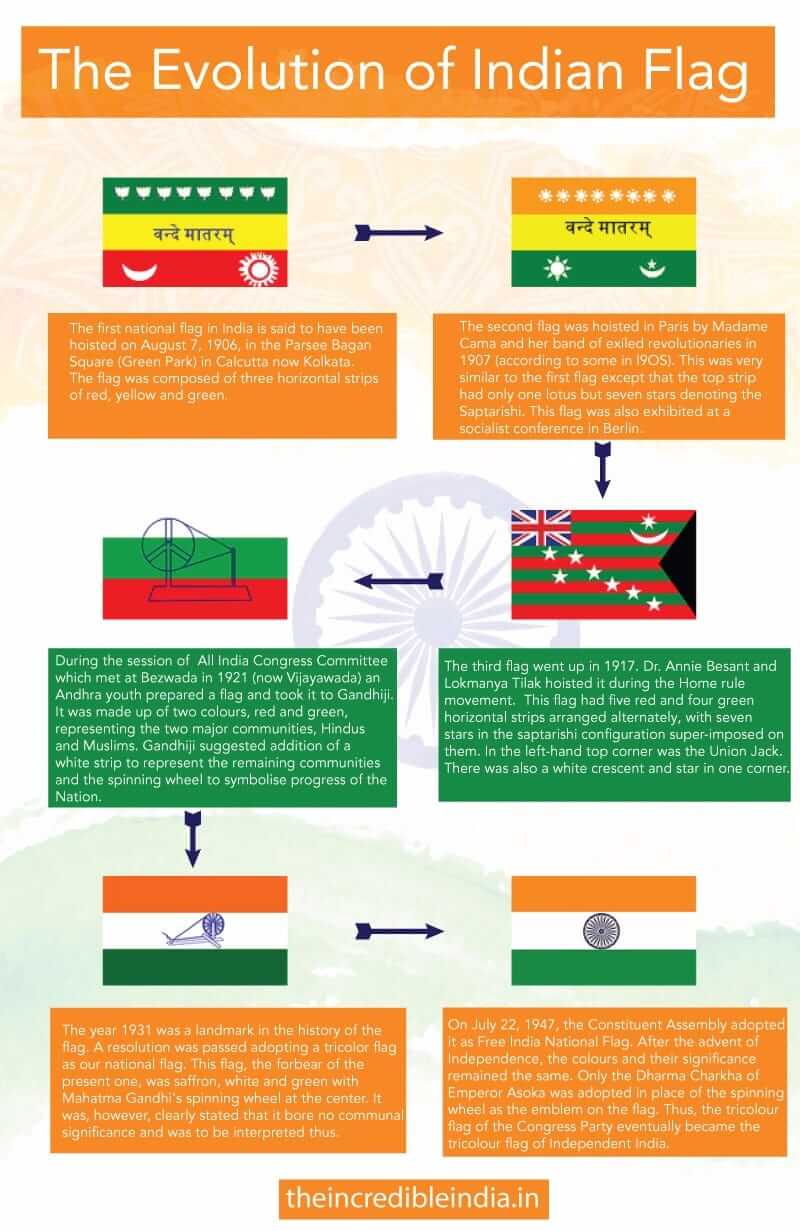National Flag Adoption Day is celebrated on July 22, every year. This day marks the adoption of the Tricolour (India’s National Flag) by the Constituent Assembly of India on July 22, 1947, a month before India’s independence from British rule.
The National Flag Adoption Day was first celebrated in 2002, by the Government of India. The day is celebrated to commemorate the adoption of the National Flag and to foster patriotism and national integration among the people of India.
About India’s National Flag
The flag was designed by Pingali Venkayya, a freedom fighter from Andhra Pradesh. The flag has three horizontal stripes of equal width, saffron at the top, white in the middle, and green at the bottom. In the center of the white stripe is a navy blue Ashoka Chakra, with 24 spokes.
- The saffron color signifies courage, sacrifice, and the spirit of renunciation, the white color peace, purity, and light, and the green color prosperity, fertility, and growth. The Ashoka Chakra represents the wheel of law and represents the Buddhist concept of dharma.
- The flag is flown at all government buildings and institutions in India.
- The flag is also flown at private buildings on special occasions, such as Independence Day and Republic Day.
- It is illegal to disrespect the national flag in India.
- The flag code of India specifies the rules and regulations for the use of the national flag.
Evolution of National Flag
- 1906: The first Indian flag was designed by Pingali Venkayya, a freedom fighter from Andhra Pradesh. The flag was a horizontal tricolor of red, yellow, and green with a white crescent and star in the center.
- 1917: The flag was modified to have a saffron color at the top, white in the middle, and green at the bottom. The crescent and star were also moved to the top left corner of the flag.
- 1921: The flag was again modified to have the Ashoka Chakra, a 24-spoke wheel, in the center of the white stripe. The Ashoka Chakra is a Buddhist symbol that represents the wheel of law.
- 1931: The flag was adopted by the Indian National Congress as its official flag.
- 1947: The flag was adopted by the Constituent Assembly of India on July 22, 1947, as the national flag of India.

History of National Flag in India’s Freedom Struggle
The national flag was a symbol of hope and inspiration for the people of India during its freedom struggle. It represented the dream of a free India, and it helped to unite the people in their fight for independence.
- The first time the Indian flag was hoisted in India was in 1906 at the Parsee Bagan Square in Calcutta (now Kolkata) by Pingali Venkayya.
- In 1907, Lala Lajpat Rai hoisted the Indian flag at the National Indian Association meeting in Lahore.
- The first time the Indian flag was hoisted on foreign soil was in 1907 at the International Socialist Conference in Stuttgart, Germany. The flag was hoisted by Madam Bhikaji Cama.
- In 1913, Lala Lajpat Rai hoisted the Indian flag at the Pacific Coast Hindu Association in San Francisco, California.
- In 1921, V.D. Savarkar hoisted the Indian flag at the First World Hindu Conference in Berlin, Germany.
- In 1928, Bhagat Singh hoisted the Indian flag at the Lahore Conspiracy Case.
- The first time the Indian flag was hoisted in the Congress session was in 1929 at the Lahore session of the Indian National Congress on the banks of the Ravi River in Lahore. Jawaharlal Nehru, the then-president of the Congress, hoisted the flag in front of a gathering of over 10,000 people.
- The Lahore session of the Congress was a historic event, as it was at this session that the Congress declared its goal of Purna Swaraj, or complete independence, from British rule. The hoisting of the national flag was a symbolic gesture of the Congress’s commitment to independence.
- In 1930, Subhas Chandra Bose hoisted the Indian flag at the All-India Students’ Federation convention in Vienna, Austria.
- In 1942, Aruna Asaf Ali hoisted the Indian flag at the Gowalia Tank Maidan in Bombay.
- In 1942, Subhas Chandra Bose hoisted the Indian flag at the Quit India Movement.
- In 1942, Kasturba Gandhi hoisted the Indian flag at the Sabarmati Ashram in Gujarat.
The national flag was a powerful symbol of India’s freedom struggle. It was a reminder of the sacrifices made by the freedom fighters, and it inspired the people to continue fighting for independence. The flag is now a symbol of India’s unity and pride.
About “Har Ghar Tiranga Campaign”
The Har Ghar Tiranga campaign was a campaign launched by the Government of India on 13 August 2022, on the occasion of the 75th anniversary of India’s independence. The campaign aimed to encourage people to hoist the Indian national flag (Tiranga) in their homes and workplaces. The campaign run from 13 August to 15 August 2022.
The objective of the campaign was to instill a sense of patriotism and national pride among the people of India. The campaign also helped to promote the national flag and its significance.
The campaign was welcomed by the people of India. People enthusiastically participated in the campaign and hoisted the national flag in their homes. The campaign also received positive feedback from political parties and other organizations.
- 3 August Current Affairs 2023 in English
- MoU Between Subroto Mukerjee Sports and Education Society and All India Football Federation (AIFF) to Promote Football at Grassroot Level
- Dr. Mansukh Mandaviya Delivers Keynote Address at the 13th Indian Organ Donation Day ceremony
- Education Ministry Forms Expert Panel on Anti-Discrimination in Higher Education
- Concerns Arise Over Cheetah Deaths at Kuno National Park

